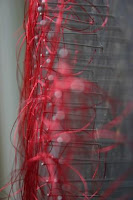
I have been responding to the feedback I received after my Contextual Studies presentation that explained that I now need to explore how I am applying the theories of Girard on mimetic desire and Turner on ritual, to my practice. I need now to begin to articulate more clearly the way that my research is feeding and developing my creative work and to feel confident in discussing the issues that I am expressing. Secondly I need to develop my phenomenological ideas about the red thread and the role of the body, perhaps looking at the ideas of boundary and the role of ritual in negotiating the boundary or threshold between the visible and the invisible, the sacred and the profane.
Desire is mimetic; in this way we learn from one another what is or is not desirable, often leading to jealousy, rivalry and finally conflict when we desire what is not ours to own, or that which is beyond our reach. Mimetic desire can also be directed beyond the material realm towards ideals of fulfillment, a sense of belonging, recognition or wellbeing. This is known as ‘metaphysical desire’ and is at the heart of many religions and faiths.
Aristotle wrote in the ‘Poetics’, ‘Man is distinguished from other life-forms by his capacity for imitation.’ Girard takes this notion one step further, suggesting that desire is not just biological or instinctual like our need to eat or sleep or inquisitive mimicry, but that mimetic desire defines our humanity and is influenced by social interaction and culture. Mimetic desire tends to lead to violence arising from rivalry; humanity desires what the other has. Violence in turn leads to more violence and he goes on to suggest that in order to break this cycle, society selects a scapegoat to sacrifice, for the greater good of the community as a whole. This scapegoat mechanism is performed through ritual, and my practical work aims to respond to the notion of ritual and sacrifice, wounding and healing, separation and ‘communitas’.
In my performance and video work my aim has been to create the experience of ritual in a gallery context; using repetitive actions, slow rhythmical movement and the use of sound to mark out rhythm and sequence. I have tried to give the viewer a phenomenological understanding of the scapegoat ritual. The violence implied by the piercing and cutting of cloth, flesh and the rose in the performance and installation aim to offer a hidden and subdued narrative; by creating a softened and aesthetic interpretation I aim to introduce the opposing truth that violence and beauty, violence and the sacred, are inextricably bound to one another.
This notion is expounded upon in Turners observations on ritual and rites of passage; in order for the beauty and metaphysical desires of the community to be met, violence and separation have to be encountered and mediated, for they are the boundary that separates the visible material world from the invisible and sacred realm. Pain and suffering, offering and sacrifice are the thresholds to the sacred realms. We therefore meet the sacred within the profane experiences of our everyday lives as we encounter death, humility and self-denial. Nature exposes us to this truth not only through the cycle of the seasons, by the cold barren stripping away of the winter months to reveal the new life and fruits of the spring. But also in the contrasts of day and night, ebb and flow, rain and sun, and the continuing cyclical process of life that stems from death.
My installation ‘Scapegoat’ explores this theme; the ongoing blood red thread or lifeline that flows forth from the tools of violence and destruction is offering hope; life continues beyond material existence, offering protection from evil and the existential dread of the eternal abyss.
The sound that I intend to accompany the work is the repetitive rhythm of a heartbeat, quietly and continuously beating within the body; the noisy drumming of machinery in the mill, and the almost silent repetitive whispers of a woman at prayer.
In Hegel’s ‘Phenomenology of Spirit’ 1939, he writes of the desire for recognition. He emphasizes the role of desire in the formation of the self stating that the human is self-consciousness, and therefore more than just a thinking subject; that to be human is to desire another on a metaphysical level, thereby transcending animal nature and instinct. In other words, as human beings we desire to be recognized by another, to become the object of someone else’s desire. This desire for recognition can lead to violence in order that we might become more recognized than our opponents. In this way Hegel places violence at the core of his thought and in so doing sacralises it, offering no alternative way. Girard however, by using the Christian revelation of Jesus’ ultimate sacrifice offers humanity a way through the boundary that separates violence from the sacred realm.
The mixed media piece on the wall creates a compressed abstract narrative of the whole work. The everydayness of the found wooden base, distressed and tarnished by the violence of everyday living is completed by the red thread suspended the length of the wooden panel as a continuum. The five wounds speak of the surrogate sacrifice whilst the painted space and waxed pyramid represent light, hope and 3 in 1, acting as a threshold to the invisible world.

No comments:
Post a Comment